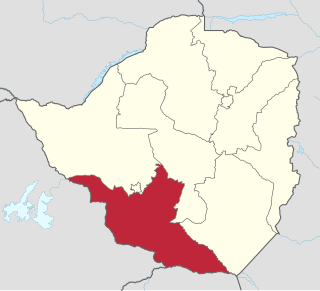
The politics of Zimbabwe occurs in a society deeply divided along lines of race, ethnicity, gender and geography. The ZANU–PF party has historically been dominant in Zimbabwe politics. The party, which was led by Robert Mugabe from 1980 to 2017, has used the powers of the state to intimidate, imprison and otherwise hobble political opposition in Zimbabwe, as well as use state funds and state media to advance the interests of the party.

Local government is a generic term for the lowest tiers of governance or public administration within a particular sovereign state.

Masvingo, previously named Victoria, is a province in southeastern Zimbabwe. It has a population of 1.638 million as of the 2022 census, ranking fifth out of Zimbabwe's ten provinces. Established by the British South Africa Company, it was one of the five original provinces of Southern Rhodesia. In 1982, two years after Zimbabwean independence, it was renamed Masvingo Province. The province is divided into seven districts, including Masvingo District, which contains the provincial capital Masvingo City.

Matabeleland North is a province in western Zimbabwe. With a population of 827,645 as of the 2022 census, it is the country's second-least populous province, after Matabeleland South, and the least densely Zimbabwean populated province. Matabeleland North and Matabeleland South were established in 1974, when the original Matabeleland Province was bifurcated, eventually losing territory in 1997 when the city of Bulawayo became a province in its own right. Matabeleland North is divided into seven districts, has its capital in Lupane, and Victoria Falls and Hwange its largest towns. The name "Matabeleland" is derived from the Matabele or Ndebele people, the province's largest ethnic group.

Matabeleland South is a province in southwestern Zimbabwe. With a population of 683,893 as of the 2012 Zimbabwean census. It is the country's least populated province after Matabeleland North.Matabeleland South and Matabeleland North were established in 1974, when the original Matabeleland Province was bifurcated. The province is divided into six districts. Gwanda is the capital, and Beitbridge is the province's largest town. The name "Matabeleland" is derived from Ndebele, the province's largest ethnic group.

Provinces are constituent political entities of Zimbabwe. Zimbabwe currently has ten provinces, two of which are cities with provincial status. Zimbabwe is a unitary state, and its provinces exercise only the powers that the central government chooses to delegate. Provinces are divided into districts, which are divided into wards.

Matabeleland is a region located in southwestern Zimbabwe that is divided into three provinces: Matabeleland North, Bulawayo, and Matabeleland South. These provinces are in the west and south-west of Zimbabwe, between the Limpopo and Zambezi rivers and are further separated from Midlands by the Shangani River in central Zimbabwe. The region is named after its inhabitants, the Ndebele people who were called "Amatabele"(people with long shields – Mzilikazi 's group of people who were escaping the Mfecani wars). Other ethnic groups who inhabit parts of Matabeleland include the Tonga, Bakalanga, Venda, Nambya, Khoisan, Xhosa, Sotho, Tswana, and Tsonga.

The Pioneer Column was a force raised by Cecil Rhodes and his British South Africa Company in 1890 and used in his efforts to annex the territory of Mashonaland, later part of Zimbabwe.

Mashonaland is a region in northeastern Zimbabwe. It is home to nearly half of the population of Zimbabwe. The majority of the Mashonaland people are from the Shona tribe while the Zezuru and Korekore dialects are most common. Harare is the largest city followed by Chitungwiza.

The Second Matabele War, also known as the First Chimurenga, was fought in 1896 and '97 in the region later known as Southern Rhodesia, now modern-day Zimbabwe. It pitted the British South Africa Company against the Matabele people, which led to conflict with the Shona people in the rest of Southern Rhodesia.

The military history of Zimbabwe chronicles a vast time period and complex events from the dawn of history until the present time. It covers invasions of native peoples of Africa, encroachment by Europeans, and civil conflict.

Gokwe South District is one of the eight administrative districts of the Midlands Province of Zimbabwe. The district administrative seat is located in Gokwe Town also known as Gokwe Centre and the District Administrator is the focal person in terms of all district administrative matters. The district is divided into two administrative entities under the Ministry of Local Government, Public Works and National Housing, which are Gokwe South Rural District Council and Gokwe Town Council. The two district administrative entities were legally setup under the Urban Councils Act of 2015 [Chapter 29:15] and Rural District Councils Act [Chapter 29:13] under the constitution of Zimbabwe. The district is further subdivided into 01 senatorial constituency, 05 parliamentary constituencies and 33 council wards. These constituencies and wards are shared between these two administrative entities of Gokwe South District. According to the 2012 ZIMSTAT National Census Statistics the population of the district was at 330 036 people. Gokwe district is in the north-western part of Zimbabwe its average temperature vacillates at 40 degrees Celsius. Gokwe South District shares its boundaries with 06 districts, namely Binga District, Nkayi District, Kwekwe District, Kadoma District, Lupane District and Gokwe North District.

The following outline is provided as an overview of and topical guide to Zimbabwe:
Europeans first came to the region in southern Africa today called Zimbabwe in the sixteenth century, when Portuguese colonials ventured inland from Mozambique and attacked the Kingdom of Mutapa, which then controlled an area roughly equivalent to eastern Zimbabwe and western Mozambique. Portuguese influence over Mutapa endured for about two centuries before fading away during the 1690s and early-1700s (decade). During the year of 1685, French Huguenots emigrated to present-day South Africa and whilst some settled there, others moved further north into the continent. Those who did, settled within modern-day Zimbabwe, Mozambique and Botswana, and co-existed with the indigenous people; most of whom, in Zimbabwe, were the Naletale people.

Harare Metropolitan Province is a province in northeastern Zimbabwe that comprises Harare, the country's capital and largest city, and three other municipalities, Chitungwiza, Epworth and Ruwa. At independence in 1980, it was originally part of Mashonaland Province which in 1983 was divided into three large provinces, Mashonaland Central, Mashonaland East, and Mashonaland West - at this point, the city of Harare became part of Mashonaland East. In 1997, along with Bulawayo, it became a metropolitan province, along with the then two nearby urban settlements. Harare Metropolitan Province is divided into four local government areas - a city council, a municipality and two local boards.

Mthwakazi is the traditional name of the proto-Ndebele people and Ndebele kingdom and is in the area of today's Zimbabwe. Mthwakazi is widely used to refer to inhabitants of Matebeleland Province in Zimbabwe.

The Pro50 Championship, formerly known as the Faithwear Metbank One-Day Competition, Metbank Pro40 Championship, Faithwear Inter-Provincial Tournament, and Coca-Cola Metbank Pro50 Championship is the premier List A cricket tournament in Zimbabwe, organized by Zimbabwe Cricket. This tournament was started after the Zimbabwean cricket crisis, recommended by the International Cricket Council (ICC). It is jointly sponsored by Metbank and Coca-Cola.

Zimbabwe Rural District Council is a rural local government arm in Kwekwe District created under the Rural District Councils Act: Chapter 20.13. It was formed from the amalgamation of the former Kwekwe Rural Council and the Mashambazhou District Council in 1993. An RDC is the administrative equivalent of an urban town council, but for a rural area.

Umzingwane is a district in the northern part of Matabeleland South province in Zimbabwe. It was formerly known as Esigodini and before 1982 as Essexvale.


















